| The Celtic Cross spread is one of the most popular Tarot spreads, providing varied insight into many aspects of a complex situation and your role in it. The William Blake Tarot explores the mystical vision and artistry of the renowned English painter and poet. Through rich interpretations focused on creative undertakings, it has long been the deck of choice for artists, writers, musicians, and thinkers. For more information about this deck, or to buy your own personal copy, go to www.blaketarot.com.
|
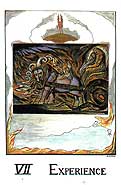 | The card not shown but at the center of the cross, represents the atmosphere surrounding the central issue. Experience: Wanting to be in control of your instincts, emotions, or elemental forces. Taking the reins in the situation. Goal-oriented drive to succeed. Journeys or involvement with motion and mobility. Meeting challenges head on. |
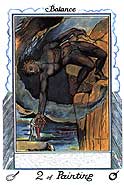 | The card visible at the center of the cross represents the obstacle that stands in your way - it may even be something that sounds good but is not actually to your benefit. Two of Painting (Balance): A choice regarding something tangible or physical. Body-awareness is a key factor; hang in there. Balance as a dynamic force. Using interaction and negotiation to keep energy flowing. Stretching your abilities to bridge a gap or to reconcile differences. In the creative process: A breach in the project requires inner strength and timely decisions; stick with the task and seek cooperative assistance. |
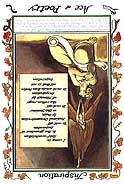 | The card at the top of the cross represents your goal, or the best you can achieve without a dramatic change of priorities. Ace of Poetry (Inspiration), when reversed: The madness of divine inspiration. The illusion of higher consciousness. Obsession with a personal vision of truth and beauty, leading to a sense of false ecstasy. Mistaking cynical seduction for creative expression. Delusion of being guided by a higher force. In the creative process: Being in contact with the purest and highest part of your being provides the impetus for fresh expressions in both art and life. |
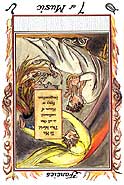 | The card at the bottom of the cross represents the foundation on which the situation is based. Seven of Music (Fancies), when reversed: A retreat into fantasy. Emotional confusion or indecision. Overwhelmed by contradictory feelings. Delusions. Temptations or bribes. Illusory goals. Challenges of immediate versus long-term gratification. In the creative process: Let your visions and dreams lead the way into deeper realms of your imagination, and be prepared to express them. Rehearse and explore wild ideas in your mind before acting on them. |
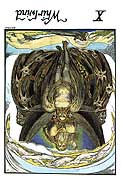 | The card at the left of the cross represents a passing influence or something to be released. Whirlwind, when reversed: Winds of change make old visions obsolete. An act of god or stroke of bad luck. Inner turmoil cleverly disguised but unrestrained. Getting the run-around. Reaching a turning point. A good time to honor your gods. |
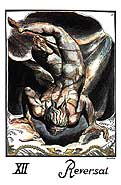 | The card at the right of the cross represents an approaching influence or something to be embraced. Reversal: Deliberately looking at the situation in a new way or from a different perspective. Brainstorming in a search for solutions. Turning things upside down, and being unconventional. Creative retreat into yourself. Acceptance of losses or reversals. Withstanding a difficult or uncomfortable position. |
 | The card at the base of the staff represents your role or attitude. Imagination: A murky situation requires wisdom and prudence. Allow your beliefs and convictions to guide you through the door of perception. Use your imagination to illuminate the unknown. Finding an answer or solution through introspection. Putting your own light and wisdom into action. Evoking the divine imagination as a transformative force in your own life. |
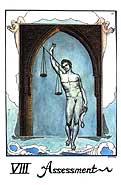 | The card second from the bottom of the staff represents your environment and the people you are interacting with. Assessment: A need to be fair and just. A situation involving judgments or balancing the issues. Consideration of commitments, agreements, or negotiations. Weighing the pros and cons of a situation. Evaluating the needs of self versus others. Transcending the limits of a situation by using kindness and imagination. |
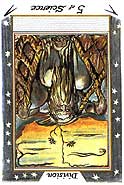 | The card second from the top of the staff represents your hopes, fears, or an unexpected element that will come into play. Five of Science (Division), when reversed: Meeting an overwhelming problem by focusing on its' component parts. Cutting yourself loose from mental hang-ups and personal entanglements. The ability to keep things separate in your mind, and to avoid conflict of interest. Swift action when faced with an impossible choice. Possibility for a new outlook. In the creative process: Caught in your own net of plans or scheme. Divide the problem into smaller segments for greater freedom of action. |
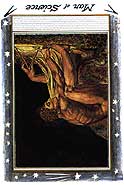 | The card at the top of the staff represents the ultimate outcome should you continue on this course. Man of Science, when reversed: Perfectionism. Personal detachment. Being oblivious to your surroundings and to unforeseen possibilities. Tendency to be opinionated and aloof. Delusions of grandeur. Inability to perceive human or spiritual values. In the creative process: Scrutinize and test every aspect of your work so as to refine and perfect it. |




















